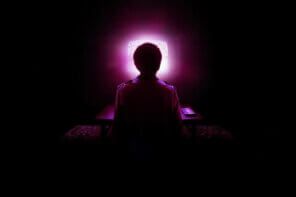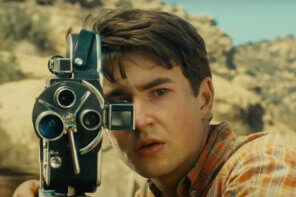David Lynch films tend to straddle and blur the line of reality; something like looking into a window with a strong reflection and losing track of what is on the other side of the glass and what is being reflected — all the while you are caught between the two worlds. Mulholland Drive embodies this more than any of his other films. In this two-act show (with one bizarre intermission) is a blurring of fantasy and reality in a ball of ambition, corruption, and desire. Lynch brings everything about Hollywood, underlying American desire, our mysterious connection to the spiritual (largely the occult hidden in the benign), and human nature into the foreground by blending the outside world with what lies in the shadows behind the glass.
 Sounds like a lot of abstract mumbo-jumbo, and, largely, it is. Lynch seems to construct his films via free form i.e. he takes any old idea that pops into his mind, which he finds interesting, and finds some subconscious connecting point to string things together. This makes for not fully abstract, but not fully coherent stories. If you are going to dive into the Lynchian you must be ready to wade into the unsettled and dark realms of the possible over the definitive. Nothing is settled except that everything is unsettled (and with Lynch it is often unsettling).
Sounds like a lot of abstract mumbo-jumbo, and, largely, it is. Lynch seems to construct his films via free form i.e. he takes any old idea that pops into his mind, which he finds interesting, and finds some subconscious connecting point to string things together. This makes for not fully abstract, but not fully coherent stories. If you are going to dive into the Lynchian you must be ready to wade into the unsettled and dark realms of the possible over the definitive. Nothing is settled except that everything is unsettled (and with Lynch it is often unsettling).
Why might something so dark and unnerving be worth watching? Between the brutality, overly sexualized, and occult what is it about Lynch that draws us into a deeper sense of introspection on human nature and our culture? Or, more honestly, can we grow from these hostile challenges to our own perceptions?
I think the answer is more similar to his films: yes… and no, all at once.
How Reality Unfolds
In Mulholland Drive Lynch develops physical and metaphysical layers of reality down to the deepest and darkest regions. The beginning of the film starts with a woman (played by Laura Harring) injured in a car accident, but not an ordinary one — she is obviously some sort of actress being driven in a limousine along, you guessed it, Mulholland Drive when her driver and his navigator pull over and attempt to assassinate her. This is prevented by a car crash that kills the assassins and leaves the actress with a bad case of amnesia. The tone of a mystery/thriller is set and this seems straightforward enough.
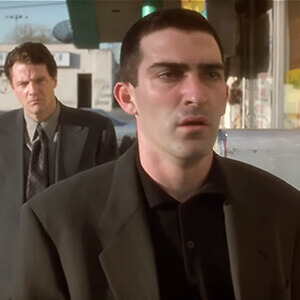 Then Lynch underlays something odd, something that appears completely disconnected from the story: two men are in a diner meant to resemble Denny’s. They are discussing the dream of one of the men in which they are at this diner and the man dies at the sight of a homeless man turned demonic creature. After elaborating the details of the dream the man’s friend suggests they reenact it to show him that it was just a dream. Their reenactment, however, leads to the same results as the dream.
Then Lynch underlays something odd, something that appears completely disconnected from the story: two men are in a diner meant to resemble Denny’s. They are discussing the dream of one of the men in which they are at this diner and the man dies at the sight of a homeless man turned demonic creature. After elaborating the details of the dream the man’s friend suggests they reenact it to show him that it was just a dream. Their reenactment, however, leads to the same results as the dream.
This is odd, at first, but as the movie unfolds we realize that this is the first glimpse into the deeper question of what really lies beneath the surface of this world’s exterior. Specifically “this world” is that of Hollywood, with a long cinematic treatment of a darkness hiding beneath the glamour. Only Lynch wants to explore a deeper, spiritual evil beneath the surface of corruption, greed, and lust for both the Hollywood dreamers (Naomi Watts) and the establishment.
From there we jump back to the benign, the wholesome, and the innocent (momentarily). Enter Naomi Watts as the young idealistic wannabe actress from small town… Canada (what could be more wholesome?). She is exiting the plane with a sweet little old lady having the politest of conversations about her aspirations and receiving warm, gracious, and sincere well wishes. Everything is just as any idealistic dreamer would imagine it, but prior to the scene’s end we catch a glimpse of grandma’s smile in hyperbole. Her smile becomes so big and intense that it is no longer kind, but menacing.
Fractured Identity
I’ll forgo the building of tension that arises as the two Watts and Harring meet each other and seek to solve the mystery of identity. But, this whole time we see juxtaposed some mob-Hollywood plot playing out to, presumably, land a role for some big time thug’s love interest. Here we return to the more basic plotline of the mystery-thriller, but Lynch never leaves off of the other reality — he is constantly leaving behind foreboding clues and images for us to wonder at. All the while a deep tension and anxiety is built in your gut as you watch — less so for the straightforward mystery, and more for the spiritual menace that seems to linger beneath the surface.
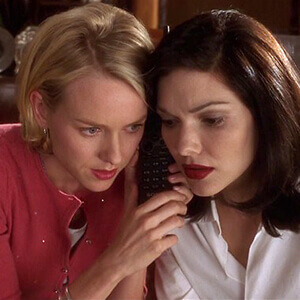 Then, as they begin to see that Harring is in danger Watts cuts her hair and they give her a blond wig that is not unlike the actual hair of Watt’s herself. Suddenly there is a shift in perspective — is this amnesia or a fractured identity? This is an incredible moment if you consider the tropes of the noir genre in which we are watching the blend of the “femme fatale” and the “redeemer” into the same character (not to mention that they have both taken the traditionally male role of the private eye). Lynch messes with everything from the traditional motifs of hair color, innocence/corruption, sexuality — he uses everything to mess with our traditional understandings of the genre.
Then, as they begin to see that Harring is in danger Watts cuts her hair and they give her a blond wig that is not unlike the actual hair of Watt’s herself. Suddenly there is a shift in perspective — is this amnesia or a fractured identity? This is an incredible moment if you consider the tropes of the noir genre in which we are watching the blend of the “femme fatale” and the “redeemer” into the same character (not to mention that they have both taken the traditionally male role of the private eye). Lynch messes with everything from the traditional motifs of hair color, innocence/corruption, sexuality — he uses everything to mess with our traditional understandings of the genre.
Now it is no longer just the characters who are blending and merging, but the film itself, and along with it the viewer who is cast into a deep discomfort and estrangement from the normal and safe realm of formula film. This is a deep dive from the systemic identification of spiritual evil to the individualistic, and it is unnerving at its climax, in the odd and early hours of the morning at a rundown theater with live performances that have the two women holding each other, moving closer together, becoming one.
A Sudden Change
Enter the second act. Lynch quickly throws us into a new story with the same characters playing different roles. There is no pause or time to reflect — we are immediately in medias res of a world in which Naomi Watts is a never-even-made-it-to-washed-up actress and Harring’s jealous lover. Harring is now switched to the more beguiling role of true noir spider woman engaged to marry a man while still retaining the presence of her lover (Watts), obviously seeking to inflict damage to Watts’ character, but to what end?
These are completely different characters, but the same characters. This is a completely different world, but the same world. In the aftermath we are left to wonder which was real and which was fantasy.
Chris Rodely, in his book Lynch on Lynch, writes:
With Mulholland Dr., Lynch adopts Lost Highway’s MÖBIUS STRIP approach to narrative but twists the story even further into a spiral. Are the first two-thirds of the film — in which Hollywood ingénue Betty Elms tries to help the amnesiac Rita discover her identity — a “dream”? Is the final third — in which Betty turns into the suicidal loser and drug addict Diane Selwyn, and Rita becomes her treacherous lesbian lover Camilla Rhodes — “reality”? Or is it the other way around, perhaps?
This shift and the whole concept of reality are magnified by the continually more surreal direction of Lynch. Even in the first and more fluid storyline the devolution of “real” elements becomes increasingly suspect. Characters are introduced who could be real, but appear more symbolic than actual. In the final scenes Lynch actually creates a shaking effect that causes the images to blur and waver (almost as if we are drugged, and either coming out of the fog or initially venturing into it). Montage cuts increase — there are no long shots that dwell in a tension, it is a growing movement from scene to scene to scene; even from image to image to image within a scene.
There is a Danger…
This analysis is not even a scratching of the surface. The reality is there is so much to dwell on and analyze within this movie it is overwhelming. This is only aided by the relative silence from Lynch himself, who rarely discusses anything approaching meaning in his work. Search out any of his interviews and you will see a man simply saying, “Yeah, it could be” to every attempt at interpretation. Instead he will focus on the creative process and certain inspirations from which he draws ideas, but never “what they mean”.
The thing is that our love for finding meaning through narrative and the enigmatic response from Mulholland’s creator on the matter combined with Lynch’s technical mastery and compelling storyline (with powerful performances to boot) creates a consuming need to understand — or at least pursue understanding. All these layers create ample space to attach some meaning, but never enough to feel completely validated.
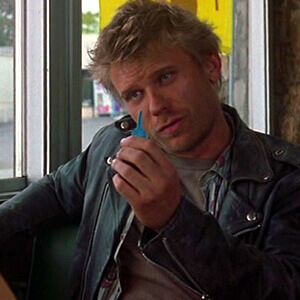 But there is a danger too. All these components that make Mulholland Dr. so compelling also place us firmly in the midst of something incredibly dark and sordid. The erotic, the suicidal, and the satanic all hold a firm footing within the film; and I must be clear — Mulholland Dr. does not come off as an endorsement of any one of these, but rather the opposite: the movie itself is an indictment of our culture at large, and our individual obsession with prestige. It is hard hitting and anxiety inducing because it touches on a reality we know to lurk inside ourselves and inside the world.
But there is a danger too. All these components that make Mulholland Dr. so compelling also place us firmly in the midst of something incredibly dark and sordid. The erotic, the suicidal, and the satanic all hold a firm footing within the film; and I must be clear — Mulholland Dr. does not come off as an endorsement of any one of these, but rather the opposite: the movie itself is an indictment of our culture at large, and our individual obsession with prestige. It is hard hitting and anxiety inducing because it touches on a reality we know to lurk inside ourselves and inside the world.
Still, with the lack of goodness (for even this is shown as a corrupted entity within our world), and complete immersion into darkness it is hard to justify recommending this as a weekend watch, or even to anyone in general. This is a film that requires some mental preparation and thoughtfulness to enter. The true danger, however, is that avoiding this preparation is too easy with film, in which we can easily just sit and passively receive any and all effects.
Before watching this the phrase Gnothi Seauton comes to mind — Know Thyself. I for one do not see myself ever watching the movie again… but, I am glad I saw it. It was over a month ago that I saw the movie, but there are certain concepts and questions that have stuck with me as if I just watched it last night.


